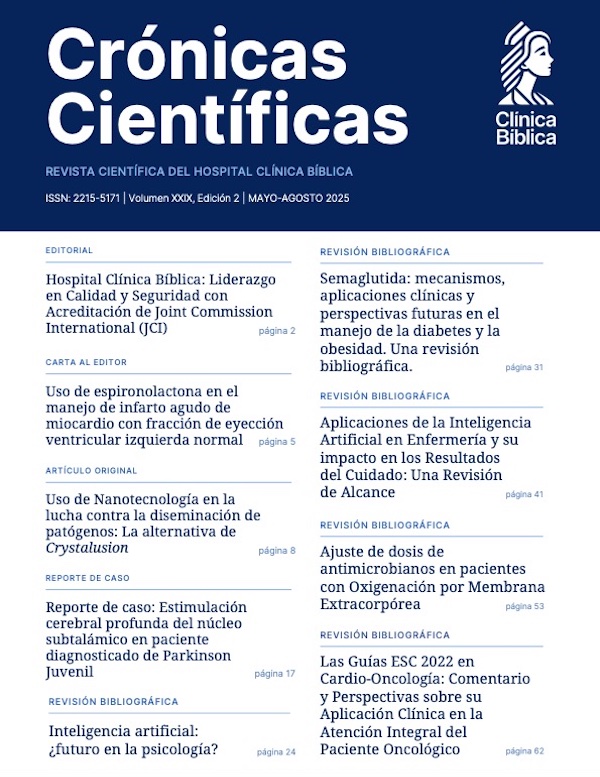- Visto: 961
APA (7ª edición)
Bustillos Villavicencio, J., Mata Brenes, C. (2016). Cirugía fetal. Crónicas científicas, 2(2), 6-13. https://doi.org/10.55139/OSNN2541.
Vancouver
Bustillos Villavicencio J, Mata Brenes C. Cirugía fetal. Cron cient. 1 de abril de 2016;2(2):6-13.
Dr. Joaquín Bustillos Villavicencio
Médico perinatólogo, Unidad de Perinatología, Hospital San Juan de Dios, San José, Costa Rica.
Miembro del Colegio de Médicos y Cirujanos de Costa Rica.
Costa Rica.
Dra. Carolina Mata Brenes
Médico general, Servicio de Gineco-Obstetricia, Hospital Max Peralta, Cartago, Costa Rica.
Miembro del Colegio de Médicos y Cirujanos de Costa Rica.
Costa Rica.
Resumen
La cirugía fetal es una alternativa para mejorar los resultados del paciente para una gran cantidad de enfermedades como lo son el síndrome de transfusión feto–feto y el mielomeningocele, entre muchas otras. Esta revisión pretende dar a conocer un tema que en nuestro país era desconocido, a pesar de que estos procedimientos ya se han empezado a realizar con éxito en nuestro medio. La aplicación del ultrasonido ha permitido la identificación prenatal oportuna y adecuada del paciente potencialmente tratable mediante estas técnicas. Se revisó la evidencia existente de los beneficios que estas terapias aportan tanto al feto como a la madre. Se concluye que es una especialidad multidisciplinaria donde participan el obstetra, el neonatólogo y el anestesiólogo, entre otros especialistas.
Palabras claves
Cirugía fetal, feto, fetoscopía, ultrasonido.
Abstract
Fetal surgery is an alternative to improve patient outcomes for a large number of diseases such as twin to twin transfusion syndrome, myelomeningocele and many others. This review seeks to highlight an issue unknown in our country, even when these procedures have been done succesfully in our health system. The application of the ultrasound has allow us the correct on time identification of patients potentially treatable with those techniques. The available evidence reviewed have concluded the benefits of those procedures on the fetus as well on their mothers. As conclusion this is a multidisciplinary specialty which requires the participation of the obstetrician, neonatologist, anestesiologist among many others specialties.
Keywords
Fetal surgery, fetus, fetoscopy, ultrasound.
Bibliografía
1. Jancelewicz, T. & Harrison, A. (2009) History of Fetal Surgery. Clinics in Perinatology 36: p227–236.
2. Kunisaki, Jennings. (2008) Fetal Surgery. Journal of Intensive Care Medicine 23(1): p33-51.
3. Deprest, J. (2010) Seminars in Fetal & Neonatal Medicine, 15: p58–67.
4. Chervenak, F.A. & McCullough, L.B. (2009) Ethics of Fetal Surgery. Clinics in Perinatology, 36: p237–246.
5. Rossi, A.C. & D’Addario V. (2008) Laser therapy and serial amnioreduction as treatment for twin-twin transfusion syndrome: a metaanalysis and review of literature. American Journal of Obstetrics & Gynecology, 198: p147–152.
6. Rossi, A.C. & D’Addario V. (2009) Umbilical cord occlusion for selective feticide incomplicated monochorionic twins: a systematic review of literature. American Journal of Obstetrics & Gynecology, 200: p123–129.
7. Golombeck, K. (2006) Maternal morbidity after maternal-fetal surgery. American Journal of Obstetrics & Gynecology, 194: p834–9.
8. Grethel, E.J.; Wagner, A.J. & Clifton, M.S. (2007) Fetal intervention for mass lesions andhydrops improves outcome: 15-year experience. Journal of Pediatric Surgery, 42(1): p117–23.
9. Hopkins, F. (2009) The Use of Ultrasoundin Fetal Surgery. Clinics in Perinatology, 36: p255–272.
10. Bruner, J.P.; Tulipan, N.B.; Richards, W.O.; Walsh, W.F.; Boehm, F.H. & Vrabcak, E.K. (2000) In utero repair ofmyelomeningocele: a comparison of endoscopy and hysterotomy. Fetal Diagnosis and Therapy, 15: p83-88.
11. Longaker, M.T.; Golbus, M.S.; Filly, R.A.; Rosen, M.A.; Chang, S.W. & Harrison, M.R. (1991) Maternal outcome after open fetal surgery: a review of the first 17 human cases. JAMA, 265: p737-741.
12. Johnson, M.P., Sutton, L.N. & Rintoul, N. (2003) Fetal myelomeningocele repair: short-term clinical outcomes. American Journal of Obstetrics & Gynecology, 189: p482-487.
13. Calvert, J.K.; Boyd, P.A. & Chamberlain, P.C. (2006) Outcome of antenatally suspected congenital cystic adenomatoid malformation of the lung: 10 years’ experience 1991–2001. ADC Fetal & Neonatal Edition, 91: F26–8.
14. Kamata, S.; Usui, N. & Kamiyama, M. (2006) Long-term outcome in patients with prenatally diagnosed cystic lung disease: special reference to ventilation and perfusion scan in the affected lung. Journal of Pediatric Surgery, 41: p2023–7.
15. Graf, J.L.; Albanese, C.T. & Jennings, R.W. (2000) Successful fetal sacrococcygealteratoma resection in a hydropic fetus. Journal of Pediatric Surgery, 35: p1489–1491.
16. Quintero, R.A.; Puder, K.S. & Cotton, D.B. (1993) Embryoscopyand fetoscopy. Obstetrics & Gynecology Clinics of North America, 20: p563-581.
17. El Kateb, A. & Ville, Y. (2008) Update on twin-to-twin transfusion syndrome. Best Practice & Research. Clinical Obstetrics & Gynaecology, 22: p63–75.
18. Feldstein, V.A. & Filly, R.A. (2003) Complications of monochorionic twins. Review. Radiologic Clinics of North America, 41(4): p709–27.
19. Chmait, R.H. & Quintero, R.A. (2008) Operative fetoscopy in complicated monochorionictwins: current status and future directions. Current Opinion in Obstetrics and Gynecology, 20(2): p169–74.
20. Crombleholme, T.M.; Shera, D. & Lee, H. (2007) A prospective, randomized, multicenter trial of amnioreduction vs selective fetoscopic laser photocoagulation for the treatment of severe twin-twin transfusion syndrome. American Journal of Obstetrics & Gynecology, 197(4): p396.e1–9.
21. Hecher, K.; Plath, H. & Bregenzer, T. (1999) Endoscopic laser surgery versus serial amniocenteses in the treatment of severe twin-twin transfusion syndrome. American Journal of Obstetrics & Gynecology, 180(3 Pt 1): p717–24.
22. Senat, M.V.; Deprest, J. & Boulvain, M. (2004) Endoscopic laser surgery versus serial amnioreduction for severe twin-twin transfusion syndrome. New England Journal of Medicine, 351(2): p136–44.
23. Rossi, A.C. & D’Addario, V. (2008) Laser therapy and serial amnioreduction as treatment for twin-twin transfusion syndrome: a metaanalysis and review of literature. Review. American Journal of Obstetrics & Gynecology, 198(2): p147–52.
24. Roberts, D., Neilson, J.P. & Kilby, M. (2008) Interventions for the treatment of twin-twin transfusion syndrome. Review. Cochrane Database of Systematic Reviews, 1:CD002073.
25. Rossi, A.C. (2010) Indications and outcomes of intrauterine surgery for fetal malformations. Current Opinion in Obstetrics and Gynecology, 22: p159–165.
26. Cannie, M.; Jani, J. & Meersschaert, J. (2008) Prenatal prediction of survival in isolated diaphragmatic hernia using observed to expected total fetal lung volume determined by magnetic resonance imaging based on either gestational age or fetal body volume. Ultrasound in Obstetrics & Gynecology, 32: p633–9.
27. Jani, J.; Cannie, M. & Done E. (2007) Relationship between lung area at ultrasound examination and lung volume assessment with magnetic resonance imaging in isolated congenital diaphragmatic hernia. Ultrasound in Obstetrics & Gynecology, 30: p855–60.
28. Cannie, M.; Jani, J. & De Keyzer, F. (2006) The use of fetal body volume at magnetic resonance imaging to accurately quantify fetal relative lung volume in fetuses with suspected pulmonary hypoplasia. Radiology, 241: p847–53.
29. Tan, T.Y. & Sepulveda, W. (2003) Acardiac twin: a systematic review of minimally invasive treatment modalities. Ultrasound in Obstetrics & Gynecology, 22: p409–19.
30. Lee, H.; Wagner, A.J. & Sy, E. (2007) Efficacy of radiofrequency ablation for twin reversed arterial perfusion sequence. American Journal of Obstetrics & Gynecology, 196(5): p459.e1–4.
31. Livingston, J.C.; Lim, F.Y. & Polzin, W. (2007) Intrafetal radiofrequency ablation for twin reversed arterial perfusion (TRAP): a single-center experience. American Journal of Obstetrics & Gynecology, 197(4): p399.e1–3.
32. Wilson, R.D. & Johnson, M.P. (2003) Prenatal ultrasound guided percutaneous shunts forobstructive uropathy and thoracic disease. Seminars in Pediatric Surgery, 12(3): p182–9.
33. Wilson, R.D.; Baxter, J.K. & Johnson, M.P. (2004) Thoracoamniotic shunts: fetal treatment of pleural effusions and congenital cystic adenomatoid malformations. Fetal Diagnosis and Therapy, 19(5): p413–20.
34. Biard, J.M.; Johnson, M.P. & Carr, M.C. (2005) Long-term outcomes in children treated by prenatal vesicoamniotic shunting for lower urinary tract obstruction. Obstetrics & Gynecology, 106: p503–8.
35. Dinneen, M.D. & Duffy, P.G. (1996) Posterior urethral valves. British Journal of Urology, 78: p275–281.
APA (7ª edición)
Bustillos Villavicencio, J., Mata Brenes, C. (2016). Cirugía fetal. Crónicas científicas, 2(2), 6-13. https://doi.org/10.55139/OSNN2541.
Vancouver
Bustillos Villavicencio J, Mata Brenes C. Cirugía fetal. Cron cient. 1 de abril de 2016;2(2):6-13.
Esta obra está bajo una licencia internacional Creative Commons: Atribución-NoComercial-CompartirIgual 4.0 Internacional (CC BY-NC-SA 4.0)

Realizar búsqueda
Última Edición
Ediciones






